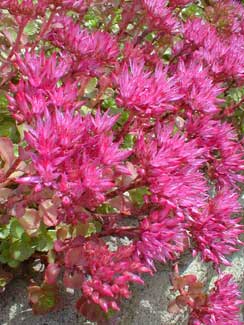
'Dragon's Blood'
Two-row Stonecrop;
aka Caucasian Sedum
"How bright atop the wall
The stonecrop's fire."
-Robert Nichols
(1893-1944)
(1893-1944)
Sedum spurium var coccineum is a red-flowering sedum often sold under the name 'Dragon's Blood' Sedum, or by its German name 'Schorbuser Blut.'
Suitable to zones 3 through 9, well drained soil is an absolute must. It thrives & spreads in droughty rockery edges. It tolerates a bit of shade but prefers lots of sun if it is to bloom well; it may not bloom at all in partial shade though its succulent leaves will still grow & spread. In the right location it spreads rapidly, & here in Zone 8 of the Pacific Northwest, it is mostly evergreen through winter.
Bronze-tipped green leaves can turn rusty red in chilly autumns. There are varieties like 'Red Carpet' with bright red leaves, 'Fulda Glow' ('Fuldaglut') with pinker bronze-red leaves, 'Voodoo' with mahagony leaves, 'Tricolor' with white-edged pink-tinged green leaves, & 'Atropurpurea' with purple leaves. 'Dragon's Blood' with regular bronze & green leaves is the most robust for creeping spread & for floriferousness.
There are also other flower colors, 'Bronze Carpet' & 'Tricolor' with pink flowers, 'Album Superbum' with white flowers, & 'Fulda Glow' as well as 'Dragon's Blood' with deep red blooms.
The crunchy leaves are regarded as edible raw. They lose their tart or bitter edge & crispness when stirfried or otherwise cooked. Their natural bitterness when raw is an acquired taste, the flavor being one that deer & rabbits tend not to want to experience. Although some yellow-flowering sedums can cause stomach upsets if eaten in large quanties, the leaves of red-flowering S. spurium are easy on the tummy.
Usually about three to four inches tall, areas of the fast-spreading mats can hump up higher at times, & the flower stems raise three or four inches above the leaves. In a good year the July flowering can be so dense that the leaves are for the month completely hidden.
When the flowers & stems go brown, they will linger quite some while & for tidiness sake may need to be removed. If left, the sedum will self-seed in August or September, though it reproduces more swiftly from leaf segments which easily root.